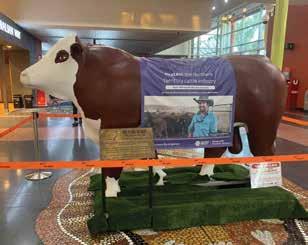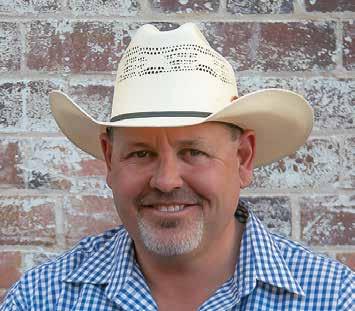
4 minute read
Here come the minis
The merits and addiction of breeding Miniature Herefords

Advertisement
If you thought breeding chooks was addictive, just wait until you purchase a Miniature Hereford. It started with a photograph of two gorgeous calves posted on Instagram by fellow local farmer in the southern highlands of NSW. Before I knew it, I had purchased two heifers named Piper and Piccadilly and was talking “potential bulls” to the breeder, former Sydney veterinarian Tony Waugh, and his artist wife Marg, who ran Apple Gully Farm at Werai, near Exeter. “You’ll have to find a bull for the girls, you know,” Tony said as I stood in his paddock patting his bull, Boomer Creek Stuart, who was blissfully munching away on a biscuit of hay with his harem of cows. This was not my experience of the Hereford breed as a child spending school holidays on my grandfather’s cattle and sheep property near Oberon in the 1970s and 80s. The thought of buying a bull and managing him on our 40ha, needless to say, had me feeling slightly trepidatious. But what was a girl (pretend farmer) supposed to do if she didn’t buy a bull for her girls? More paddock ornaments we did not need! More mouths to feed which did not produce anything we did not need (chooks not included). While I am no social media aficionado, trawling across Facebook I managed to find Toni Hall from Taraloo Miniature Herefords at Parkes with a placid two-year-old bull for sale. Our road trip later to the Central West with the horse float to collect Taraloo Patrick (and of course a paddock mate for him named Qwinto) and our “herdette” at Fiddlewood Farm had begun. While I have a tad of cattle breeding in my DNA, it was 35 years since I had been in a stockyard or bellowed “Com’ on!” across a paddock to beckon cattle in for a feed. I certainly had never tried to coax a bull onto a horse float, albeit with a halter and a bucket of feed. My ever-patient animal loving husband did not bat an eye when I said I was buying a bull and he needed to drive with me to Parkes on an overnighter to collect him. Inside, he was probably rolling his eyes as our menagerie of animals continued to expand. Aside from testosterone issues at the boundary fence and a brief wander out a gate down the lane to search for the neighbour’s heifers, Patrick has been a good boy in all senses of the word. No doubt this stems from his solid genetics and handling by the Hall family who bred him. Patrick knows his name and comes 1 when called. Electric fencing is of course essential – the barbwire was not enough as I had naively presumed. I hear you seasoned farmers laughing! Last spring, we were blessed with four gorgeous calves and no calving issues. Patrick also had a holiday with a friend’s Angus heifers with a 20 out of 20 success rate. If you are looking for a smaller bull to join with your heifers, I cannot recommend the Mini Hereford highly enough. The designation “Mini” is admittedly, a little deceptive. They might be a little shorter than your standard Hereford but a beef cow they definitely are. With a placid temperament, they will produce a solid beef cow for you. A 600kg steer by the age of two to three years is not uncommon. The long and short of it…the breeding program at Fiddlewood Farm continues to expand. Four cows later quickly became six this year with another three calves on the ground in October. My husband is “on watch” for cows going into labour and has now acted as veterinary assistant to help deliver his first calf to an overweight heifer with our former vet who just happened to be coming for a visit. Serendipity! 3 Six cows this year is rapidly on the way to 11 with heifers coming up from Victoria in November from the Davey family at Shady Creek. This farming gig is addictive and the Mini Herefords have been a delight so far. If only I had more grass! I am ever-grateful for the knowledge imparted every month through our online group of seasoned cowboys and cowgirls – the Australian Miniature Hereford Breeders Network. From handling and nutrition to demonstrations using calf pulling chains and making the most of the HAL website where we can register our stock and generate mating prediction spreadsheets, this network has been invaluable for us as we navigate our way as new farmers. You can read more about the Network and Mini Herefords on the website www.amhbn.com. By Susan Tankard Fiddlewood Mini Herefords, High Range, NSW

1. The Miniature Hereford can grow into 600kg steers at two to three years of age. 2. A new calf born this year at Fiddlewood Farm. Images Susan Tankard. 3. The Miniature Herefords are known for their docility making them ideal for small holdings. 4. Quinto and Patrick at Fiddlewood Farm.









